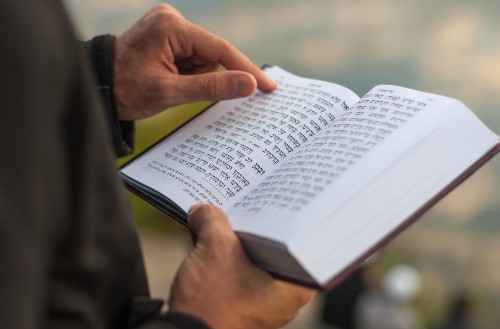One who prays must have in mind the meaning of the words that he utters with his mouth, and he should think to himself that the Shechinah is in front of him. He must eliminate all thoughts that trouble him until his thoughts and attention are clear for prayer. He should think that if he were speaking before a flesh-and-blood king, he would arrange his words and concentrate on them properly to ensure he does not make a mistake; all the more so [should this be done] before the King of kings, the Almighty, Who looks into all our thoughts.
These words are found in the Shulchan Aruch (Orach Chaim 98), in discussing the laws of tefillah. The Yesod VeShoresh HaAvodah urges us to review this chapter at least once a month in order to reinforce our commitment to praying with the proper kavannah (intention).
The Shulchan Aruch here speaks of two different aspects of kavannah:
- The meaning of the words
- To be cognizant that one is standing before G-d
The first kavannah — paying attention to the meaning of the words — is mandatory only during the first berachah of the Amidah. Although it is certainly preferable and advisable to concentrate on the meaning of the words throughout the prayer service, technically speaking this kavannah is essential only during the first berachah. If one did not pay attention to the meaning of the words while reciting this berachah, he has not fulfilled his obligation, whereas if one failed to have this kavannah during the other parts of the tefillah, he has satisfied his requirement.

However, Rabbi Chaim of Brisk, in a famous passage in his commentary to the Rambam’s Mishneh Torah (Hilchos Tefillah 4:1), establishes that the second kavannah, thinking that one is standing before the Almighty, is halachically essential throughout the entire Amidah prayer. He writes:
It would seem that this intention does not stem from the particular requirement of “kavannah,” but is rather integral to the act of prayer. If one’s heart is not attentive, and he does not see himself standing before G-d and praying, this is not an act of prayer…
Rav Chaim explains that the act of prayer, by definition, requires that one have in mind that he is speaking to Hashem. This is not just an obligation that is relevant to prayer; it is essential to the very definition of prayer. If one recites Hebrew text without thinking that he is speaking to his Creator, then he is not engaged in prayer. Rav Chaim draws an analogy to the halachic concept of misaseik, whereby an act performed without any intention does not constitute a halachic act. For example, one who momentarily forgets that it is Shabbos and turns on a light has inadvertently committed an act of Shabbos violation, but one who unwittingly flips on the switch while stretching is not considered to have committed a prohibited act at all. Since he had no intention to turn on the switch, he is not halachically regarded as having performed this act. Similarly, a person who recites a liturgical text without bearing in mind that he is speaking to G-d has not prayed at all. Therefore, Rav Chaim asserts, this second kavannah is essential throughout the entire Amidah prayer, as it constitutes an integral component of the very definition of prayer.
Others, including the Chazon Ish, dispute this position, and maintain that even this kavannah is essential for fulfilling the prayer obligation only during the first berachah. Be that as it may, it is clear that according to some leading halachic authorities, we must have in mind throughout the Amidah prayer that we are actually standing before G-d and speaking to Him.
And this is not just imaginary; it is an actual reality. Halachah forbids walking in front of someone who is praying the Amidah, and the Bach explains that this is not only to avoid disturbing the worshiper’s concentration, but also because the Shechinah is present in front of the person praying. As such, the ground in front of him is sacred, and one may not tread upon that sacred ground. We must recognize that G-d’s presence is truly in front of us as we pray.

This requirement of kavannah is also discussed by the Mesillas Yesharim, in Chapter 19. It describes how one must think while praying — “that he truly stands before the Creator, may His Name be blessed, and converses with Him, even though the human eye cannot see Him.” The Mesillas Yesharim adds that although we cannot perceive G-d with our physical senses, we are capable of achieving this kavannah, and experiencing the feeling that we are standing before G-d, with just a bit of effort and concentration:
With a little contemplation and concentration, one can establish the truth of this matter in his heart, how he is coming and actually conversing with Him, may He be blessed, and it is before Him that he pleads and from Him that he makes his request. And He, may He be blessed, listens to him and hears his words just as when a person speaks to his fellow and the fellow listens to and hears him.
This is the most essential and fundamental aspect of prayer — putting ourselves in the mindset that we are standing before the Almighty and speaking to Him.
Of course, this is not an easy mindset to achieve. Rabbi Ades observed that this challenge is so difficult because throughout the day our minds are occupied and we have so many pressures and responsibilities to attend to. This mental preoccupation denies us the peace of mind necessary for us to attain this mindset that we are standing in the presence of G-d. The more we are able to bring G-d into our thoughts even amid the pressures of our daily routine, the easier it will be to have this mindset when we pray.
Additionally, Shabbos affords us the perfect opportunity to work on this kavannah. On Shabbos, we are finally free from the pressures of our business, from the constant stream of emails, phone calls and text messages, and our minds are, hopefully, less cluttered and more relaxed. We should take advantage of this opportunity and make a special effort on Shabbos to think of how we are standing before G-d when we pray. This is the perfect time to train ourselves to have this mindset and feeling during tefillah.
In the upcoming lessons, we will delve into selected passages in the special Shabbos prayers to help us appreciate their meaning and concentrate more fully when we recite them. But first, let us try to focus on this more basic and fundamental aspect of tefillah, of focusing our thoughts on recognizing that we are truly and literally standing before our Creator every time we pray.
—————————————————————-
Reproduced from Living Shabbos by Rabbi David Sutton
ArtScroll / Mesorah Publications Ltd. Reprinted with permission.





